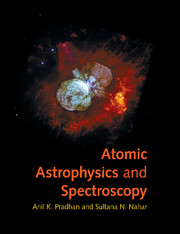Book contents
- Frontmatter
- Contents
- Preface
- Acknowledgements
- 1 Introduction
- 2 Atomic structure
- 3 Atomic processes
- 4 Radiative transitions
- 5 Electron–ion collisions
- 6 Photoionization
- 7 Electron–ion recombination
- 8 Multi-wavelength emission spectra
- 9 Absorption lines and radiative transfer
- 10 Stellar properties and spectra
- 11 Opacity and radiative forces
- 12 Gaseous nebulae and H II regions
- 13 Active galactic nuclei and quasars
- 14 Cosmology
- Appendix A Periodic table
- Appendix B Physical constants
- Appendix C Angular algebra and generalized radiative transitions
- Appendix D Coefficients of the fine structure components of an LS multiplet
- Appendix E Effective collision strengths and A-values
- References
- Index
2 - Atomic structure
Published online by Cambridge University Press: 05 June 2012
- Frontmatter
- Contents
- Preface
- Acknowledgements
- 1 Introduction
- 2 Atomic structure
- 3 Atomic processes
- 4 Radiative transitions
- 5 Electron–ion collisions
- 6 Photoionization
- 7 Electron–ion recombination
- 8 Multi-wavelength emission spectra
- 9 Absorption lines and radiative transfer
- 10 Stellar properties and spectra
- 11 Opacity and radiative forces
- 12 Gaseous nebulae and H II regions
- 13 Active galactic nuclei and quasars
- 14 Cosmology
- Appendix A Periodic table
- Appendix B Physical constants
- Appendix C Angular algebra and generalized radiative transitions
- Appendix D Coefficients of the fine structure components of an LS multiplet
- Appendix E Effective collision strengths and A-values
- References
- Index
Summary
As mentioned in the first chapter, astrophysical applications played a crucial role in the development of atomic physics. In their 1925 paper, Russell and Saunders [2] derived the rules for spectroscopic designations of various atomic states based on the coupling of orbital angular momenta of all electrons into a total L, and the coupling of all spin momenta into a total S, called the LS coupling scheme. Each atomic state is thus labelled according to the total L and S.
Atomic structure refers to the organization of electrons in various shells and subshells. Theoretically it means the determinations of electron energies and wavefunctions of bound (and quasi-bound) states of all electrons in the atom, ion or atomic system (such as electron–ion). As fermions, unlike bosons, electrons form structured arrangements bound by the attractive potential of the nucleus. Different atomic states arise from quantization of motion, orbital and spin angular momenta of all electrons. Transitions among those states involve photons, and are seen as lines in observed spectra.
This chapter first describes the quantization of individual electron orbital and spin angular momenta as quantum numbers l and s, and the principal quantum number n, related to the total energy E of the hydrogen atom. The dynamic state of an atom or ion is described by the Schrödinger equation. For hydrogen, the total energy is the sum of electron kinetic energy and the potential energy in the electric field of the proton.
- Type
- Chapter
- Information
- Atomic Astrophysics and Spectroscopy , pp. 15 - 45Publisher: Cambridge University PressPrint publication year: 2011



